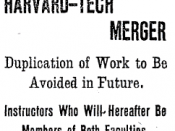MERGER: A+B=C
ACQUISITION: A+B=A
Mergers - defined as an amalgamation of two or more firms to form one new company
RECENT MERGERS:
Norwich Union+ CGU
Walmart+Asda
Natwest+Bank of Scotland
AOL+Time Warner
Wellcome+ BeechamKline
TRENDS:
Controlled in the UK since 1965 Monopolies and Merger Act, subsequently repaled by the Fair Traiding Act
Occurs in waves:
1.wave 1920
2.wave 1960
3.wave 1970
4.wave 1980
REASONS FOR MERGERS:
1.growth
2.economies of scale
3.power
4.better management
5.accumulated knowledge
6.stability
7.diversification
8.incerease market share and eliminate competition
TYPES OF MERGERS:
CONCETRIC MERGERS: the organisations acquired is in an unfamiliar but related fields into which the acquiring company wished to expand
HORIZONTAL MERGERS: firms producing the same product merge
VERTICAL MERGERS: firms at various stages in the production process merge
CONGLOMERATE MERGERS: firms poducing intirely different products merge
ASSESSING MERGER GAINS:
* Motive for M&A is to make 2+2=5, 'synergy effect'
(Cartwright and Cooper, 1992)
* Expectation:
combination will result in increased ifficiency, economies of scale, widening of markets, greater purchasing power, and in consiquence, increased profitability
*Managerial assessment
*Earning performance
*Fluctuation in share prices
(Newbould, 1970; Hovers, 1973; Meek, 1977)
EFFECT ON EFFICIENCY:
*A change in profitability could arise from a change in efficiency
*Impact on efficiency is drawn from impact on profitability e.g.,
if profit declines, ifficiency has declined too
*'efficiency gains from mergers in general are mot found'
*(Cowling et al: 1980)
* Similar results also found by Newbould (1970)
HIGH RATE OF MERGER FAILURE:
*Mergers have an unfavourable impact on profitability
*Associated with :
1.lowered productivity
2.worse strike records
3.absenteeism
4.poorer accident rates
*rather than greater profitability (Meek, 1977)
" In long-term, 50-80% of all mergers and takeovers is financially unsuccessful" (Ellis and Perker, 1987)
ADVANTAGES:
1.Economy in cap tal expenditure
2.Economy in the use of current assets
3.Ease of access to the capital market
4.Saving in overhead expenses
5.Research expenditure
6.Diversification of industry
DISADVANTAGES:
1.Elimanation of the personal touch
2.Loss of trade name
3.Inconvenience and expense
4.Monopoly powers
5.Personality problems
AN INTRODUCTION TO INDUSTRIAL ECONOMICS, P J DEVINE ET AL, 1985, GEORGE ALLEN & UNWIN LTD.
THE HISTORICAL RECORD OF MERGER ACTIVITY
Merger activity has been measured in several ways: by the number of mergers occurring per year; by the price paid by the acquiring firm. By merger is usually intended the amalgamerion of two or more firms , whether by consolidation into a new legal intity or by the acqusition s the largest firm involved in a consolidation is normally consedered to be the acqurer.
A striking indication of the importance of merger activity is the fact that ocer the period 1964- 71 the average continuing quoted company grew mwre by merger than by net investment in fixed asets.
Types of merger: during the period q966-73 mergers in distriburion, property and finance an increasingly signeficant proportion of all mergers, with their valur exceeding tyhat of mergers in manufacturing after 1970.
Singh: 488 companies in manufacturing industry acquired b-n 1948-1960 nearly 60% involved amalgamations.
Utton: 643 companies acquired in the period 1954-65 69.8% by number and 81.1 % by valu as horizontal acquisitions.
Newbould : 407 mergers in 1967 -196880 horizontal .
Kuehn : 117 companies 1957- 69 74.% as horizontal
Singh has referred to a worldwide merger movement and has attributed it in part to the intensification of intercational compatition associated with the tradw leberalisation and increased capotal movements dating from the late 1950. He has pointed to evidence that in Wstern Europe and Japan merger has been seen as the way to attain larger size in order to face competition from larger USfirms.
REASONS FOR MERGER
Markham has suggested that each period of high merger activity should be considered weparately sice it is likely that there will be specific factors in each case from which it would be misleading to abstract.
Synergy: monopoly power and scale economies(*)
"Synergetic effects": effects resulting from the meshing together of firms in such a way that their profits when merges exceeed what the sum of their individual profits would have been had the firms remained unmerged.
Empirical studies are often contradictory and inconclusive. *Nelson has concluded that his findigs on the turn-of-the-century merger wave in the US "tend to demonstrate the existrnce of a firly strong desire to avoid riforous competition.
*Markham on the other hand speaking of the same period, has concluded:
1)If the purpose of all mergers was monopoly power, four out of every five were unsuccessful in obtaining their initial objective, or
2)many mergers were formed for other purposes
His general conclusion for all mergers up to the mid-1950s was that relatively few had market monopoly as their foal.
*Stigler hasdargued that the conspicuous ability of different -sized firms to suvive in the same industy suggests prima facie that ceconomies of scale are relateverly unimportant over a wide r5ange of American industry
*Cook and Cohen on the basis of a vary detailed series of industy case studies, have concluded: "The case studies have indicated that mergers are unlikely to be successful unless there are considerable ecinimies of scale, and that they are unlikely to take place unless those economies of scale are difficult to realise inthe absince of mergers.
*Gort has argued that, if the motive is monopoly power merger activity should be associated with industries in which there are few dominant firms, high entry barriers and slow growth: whereas merger for scale economies should be associated with industries in which the average firm size increases, there are many entrants and growth rates are slow. On the basis of simple correlation coefficiets and regression anlysis, merger activity was found to be most closely related to a measure of technical change.
Expectation and market valuation (*)
Gort's hypothesis. By discrepancies in valuation are meant situations in which the potential buyer and seller, although neither forsees a rise in stock market valuation resulting from the merger, both expect to gain from the transaction.. "Discrepancies in valuation for income-producing assets arise from differnces in expectations about futyre income streams and the risks associated with expected income. When such discrepancies are characterised by a higher value being placed on the assets of a firm by nonowners than by owners , acquisition becomes possible. He has regarded his finding , that merger activity is most closely associated with the technical personnel ratio, the concetration ratio and industy growth as consistent with his hypothesis.
The business cycle and the stock market. (*)
Will establiched and gtenerally agreed is that ther is a very lose relationship bitween merger activity and stock market conditions.
An early attempt to explain this relationship was the hypothesis that merger when security prices were buoyant"permitted a capitalisation of prospective monopoly profits and a distribution of a portion of these capitalised profits to the professional promoter."
Markham has identified auch profits as in feneral the most important singe motive at merger peaks;
Above Hypothesis has been dismessed by Gort on the grounds that, since most acquisitions are financed by share exchange and any cash used has in the main been accumulated internally by the acquiring firm, the scope for gains by the promoters of mergers is too small to provide and adequate basis for a general theory of merger. His alternative, is that high levels of security prices are a contrivutory factor in creationg a situation in which valuation discrepancies are large enough to call forth merger transactions.
(*) - means reasons based on assumption of profit max as an objective
Merger growth
In the case of the hypotheses of merger for monopoly and merger for scale economies the discussion has been conducted within the framework of the traditionsl theory of the firm. Explanations of merger activity have also been advanced on the alternative assumption of growth maximisation as the fiem's objective.
Mueller's theoty is premised on the assumption of a separation of ownership from control, sharehilders seeking prfit and managers seeking growth. He has argued that:" The essence ofthe diffreince between growth and stockholderwelfare-maximising behaveout is the lower cost of capital or dicsouct rate employes by the growth -maximising managers." The cost of capotal or discount rate imployed is lower for the managers than for the shareholders because the former conseder only internal investmect oppotunitues, being interested inthe growth ofthe firm thery control, whereas the latter cosseder both internal and external investment opportunities ,being interested in the return on thier investment.
Managerial ability must be a non-specialised proclivity, and the leaders of the acquiring company must be men of much greater talent than those of the corporations they absorb.
An attempt tp dicarimacate b-n the alternative hypotheses of merger for growth and merger for progit has been made by
Reid. He has used 3,3000 acquisitions . The firms were diveded into four groups. Firms that relied solely on internal growth grew on average faster than the firms with a low merger intensity but more slowly those with a high meger intensity.
On the other hand, non-merging firms had a strikingly better record than merging firms from the standpoint of the original shareholders. Further analysis suggesterd that firms engaging in pure conglomerate type mergers grew most rapidly, while firms engaging in pure internal growth grew most profitable, although growth by conglomerate type merger was more profitable than growth by other types of merger. Reid has merely argued that merger tends to be for growth, not for profitability. However, also merger is the result of the internal and external pressures and opportunities confranting the firm.
The environment, uncertainty and rivalry
Newbould's own theory mey be summarised as follows. Changes in the environment in which a firm has been operating ,which may include merger by competitors, cause the firm's managers to experience increades uncertainty. This increased uncertainty produces a desure to merge in order to reduce uncertainty.. Merger occurs if the desire to mergr is accompanied by managerial ability and willingness to carry through an actual merger.
Two processes are at work. On the one hand, as the degree of uncertainty increasesthe desire to merge increases;theis tends to increase the number of actual mergers, and this in turn inceases the degree of uncertainty..On the other hand, the mere that uncertainry increases the more hesitancy there is in undertaking any actyal merger, while the moer actyal mergers there are the lower is the ability to carry thtough further mergers.
Deorgw and Silberston have argued that mergers occur when the relationship b-n firms and their environmnt is distubed by changes in latter. They have suggested that the amount of comprtition that is acceptable is limites:" Any marked or sudden chagesin the environment will lead to changes in industrial structure or business behaviour.""In a world characterised by uncertainty too much monopoly power is always better, from the firm's point of view, than too little."
Aaronovitch and Sawyer have advocated an pproach to merger that "the costs of rivalry" generated by the process of oligopolistic rivalty which fall on the firms involved and would be reduced if rivalry were reduced .The costs in question are those of undesired excess capacity, research and developmentm and promotion and marketing. Th major destabilising force to which Aaronovitch and Sawyer have drawn attention is the intensification of international competition. they have examined the relationship b-n indices of international competitiveness and merger activity. The experctation that ther would be more mergers the worse the balance on cuurnt account and the higher the level of imports was confirmed.
An assessment
No gecerally agreed thaeory has been developed. The profit and growth maximistion hypotheses has been recast in terms of their effect on share prices and hence the probability of takeover.
THE EFFECTS OF MERGER
Interest on the effects of merger has for the most part been motivated by welfare considerations , although more recently their role in shaping the longer term evolution of the socioeconomic system. cook and Cohen have pinpointed the general difficulty ib the introduction to their detailed cade studies: " mergers are a reaction to a changing situatin.. judgement depends upon comparing the effects of what actually happened with the effects of what might have happened.
The effect of merger on concerntration and the large firm
B-n 1954 and 1965 merger accounted for over 40 % of the increase in concentration in UK manufacturing industry. Hart, Utton and Walshe , on the basis of forty-two product-group case studies covering the 1958-63 , have concluded that mergers and internal growtyh were equally inportant in increasing concentration within priduct groups.
Hannah AND Kay, using the same basic methid as Utton but with
concentration ratios and a cumber-equivalent index . Their results provide very strong evidince of the connection b-n mergers and concentration. B-n1919-30 , concentration on UK manufacturing industy increased very substantioally , with merger responsible for over50 % of the increase.
Whitington, in an analysis of uaoted UK manufacturing companies over the period 1948-68, has concluded that the net assets of the top 100 grew rapidly by comparison with those of the rest of the company sictou -by620 as aginst 450 % -and taht this was almost certainly sue to thae effect of mergers.
Ince established, large firms tend to occupy a special place in the merger process. Large firms take over small firms , cot the other way round.. Thus merger activety emergers as an important instrumernt in the rise of firms to a suminact position and as and important activity of firms once a dominant position has been achieved.
The success of mergers
Utton and Meeks have concluded that in general merger does not improve profitability performance, with Utton's more comprehainsive summaty reporting six studes in which performance did not chnge sgter merger, five in which it wordeced and only two in which it improved.
Thus, the evidence does not suport the view that mergers are in general successful from the standpoint of incrading prfitability. on the other hand, there is accumulating evidence that merging fims grow faster than non-mering firms. This was clearly the case in Newbould's , Utton's and cosh et al. 's studies for the UK and also in Reid's study for the US. It may be the case, for instance, that firms that merger do so for reasons that aare specific to them and that do not apply to other firms in the industry and that their proditability performace would have been even worse than it rurned out to be had they not merged.
Willamson has proposed a model in which the welfare losses arising form any increased mpnopoly power due to a merger are compared with any gains arising form greater efficiency due to the merger.
cowling and Mueller have arfuedthat the welfare losses assoceated with monopoly power are hich. "...There are one or two cases wher we have siin an efficiency gain which has followed from the merger, these cases being where superior manage ent has gainned control over mare resources."
The available empitical evidence suggests that merger gas played and importainty part in the growth of concentration and the rise of the giant corporation.
MERGER p340-341.
The Fair Trading
act 1973 also enables the Secretary of Stare to refer a merger to the monopolies and mergers Comm. if ti would create or strengthen a monopoly sityation, sifines as control pver at least one-quarter of a given categoty of supply, or if it would involve the caqu7isition of assets whose value exceeded oe5 million( incrased to oe15 million in 1980). The guedance given in the Act on how to interpret the publec interest inthe case of merger is the same as that quoted above with respect to monopoly. Undertakings and Orders may cover the prevention or breakup of the merger or may relate to the future conduct of the merged company.
The guidance given in the Act on gaw to interpret the public interest is as follows:
1. effctive competition b-n persons supplying goods and servised in the UK
2. of promoting the intrersts of consumers, prchasers and other users of goods and servised in the UKin respect of the prices charged for them and quality, variety of goods.
3. of promotiong, through competition m the reduction of costs and the developmect nd use of new techiques and new products, and of facilatationg the entry of new competitors into existing markerts.
4. of maintaincing and promoting the balanced distribution of industry and imployment in the UK.
5. of mainticing and promoting compereve activity in markets outsidw the UK on the part of producers of goods , and of suppliers of goods and services in the UK


